 Our generation is not used to stockpiling – quite the opposite, there were times when we were discreetly smiling to one another at the table when hearing how many jars of preserves landed in the larder. When I come to think about it, there were seasons so abundant that my hands were becoming numb with all the peeling and cutting. Who would have thought that a time would come when a jar with fried white transparent or cooked tomatoes would be treated with the greatest gravity. The current situation is imposing limitations on us that we are rigorously following. We occasionally leave our home to do the shopping at a local store and buy a few basic products. What will the future bring? Well, I don’t know. We live from one day to the next. The only thing that we’re planning are meals together and just like everyone, we are glad that we can spend time together.
Our generation is not used to stockpiling – quite the opposite, there were times when we were discreetly smiling to one another at the table when hearing how many jars of preserves landed in the larder. When I come to think about it, there were seasons so abundant that my hands were becoming numb with all the peeling and cutting. Who would have thought that a time would come when a jar with fried white transparent or cooked tomatoes would be treated with the greatest gravity. The current situation is imposing limitations on us that we are rigorously following. We occasionally leave our home to do the shopping at a local store and buy a few basic products. What will the future bring? Well, I don’t know. We live from one day to the next. The only thing that we’re planning are meals together and just like everyone, we are glad that we can spend time together.
* * *
Nasze pokolenie nie przywykło do robienia zapasów – wręcz przeciwnie, bywały chwile, że dyskretnie uśmiechaliśmy się do siebie przy stole, słysząc ile to słoików zapraw znów wylądowało w spiżarce. Sięgając pamięcią, zdarzały się sezony tak obfite w owoce, że dłonie nam drętwiały od obierania i krojenia. Kto by wtedy pomyślał, że nadejdzie chwila, kiedy słoiczek podsmażonych papierówek albo gotowanych pomidorów, traktowany będzie z największym namaszczeniem. Obecna sytuacja wymusza na nas ograniczenia, których trzymamy się rygorystycznie. Sporadyczne wyjścia z domu odbywają się wyłącznie do osiedlowego sklepiku, po kilka podstawowych produktów. Co będzie dalej, nie wiem. Żyjemy z dnia na dzień. Planujemy jedynie wspólne posiłki i tak jak każdy, cieszymy się, że jesteśmy razem.

Ingredients:
(recipe for 4-6 portions)
approx. 1 kg of beef in one piece (e.g. beef shoulder, shank, or chine)
1-2 tablespoons of smoked paprika (it’s best to not omit it for the sake of the taste)
2 onions
approx. 250 g of champignons
4 cloves of garlic
approx. 600/800 ml of home-made tomato sauce or passata
4 – 5 allspice corns / 4 bay leaves / dried oregano
freshly ground pepper / sea salt
2 pieces of puff pastry
for spread:
1 yolk
served with:
sour cream mixed with a tablespoon of olive, a handful of fresh coriander or parsley
* * *
Skład:
(przepis dla 4-6 osób)
ok. 1 kg mięsa wołowego w kawałku (np. łopatka, pręga lub karkówka wołowa)
1-2 łyżki wędzonej papryki (dla dobra smaku lepiej nie pomijać)
2 cebule
ok. 250 g pieczarek
4 ząbki czosnku
ok. 600/800 ml domowego przecieru pomidorowego lub passaty
4- 5 ziarenek ziela angielskiego / 4 liście laurowe / suszone oregano
świeżo zmielony pieprz ziołowy / sól morska
2 płaty ciasta francuskiego
do posmarowania: 1 żółtko
do podania: kwaśna śmietana wymieszana z łyżką oliwy, garść świeżej kolendry lub pietruszki

Directions:
1. To prepare the stew: dice the washed and dried meat (I recommend sharpening the knife beforehand as you’ll have a lot of cutting). In a wide, iron-cast dish, heat up some olive oil and slightly fry chopped garlic, onion, bay leaves, allspice corns, and smoked paprika (it’s an important moment as it’s all about filling the dish with the fragrance of all the spices). Add cut meat pieces and fry until the meat is ready. Season everything with salt and freshly ground pepper. Pour the tomato passata into the dish, decrease the heat, and cook for at least 40 minutes, stirring from time to time, so that the stew doesn’t stick to the bottom.
2. To prepare the casserole: line a greased heat-resistant dish or baking tray with puff pastry. Note: you can slightly bake the bottom first in an oven pre-heated to 200ºC. That’s how you can avoid a raw bottom. Then, spread the stew on the bottom (you don’t need to heat it up beforehand). Cover it with the remaining piece of the puff pastry. Incise the top layer and cover it with whipped yolk. Bake everything in an oven preheated to 200ºC for approx. 20 minutes. Serve hot with sour cream mixed with a little bit of olive oil and fresh coriander.
* * *
A oto jak to zrobić:
1. Aby zrobić gulasz: umyte i osuszone mięso kroję na małe kawałki (tu polecam wcześniej naostrzyć nóż, bo krojenia jest sporo). W szerokiem, żeliwnym naczyniu rozgrzewamy oliwę i delikatnie podsmażamy posiekany czosnek, cebulę, pieczarki, liście laurowe, ziele angielskie oraz wędzoną paprykę (to ważny moment, gdyż uwalniamy zapach wszystkich ziół). Dodajemy pokrojone kawałki mięsa i smażymy, aż mięso będzie gotowe. Doprawiamy solą, oregano i świeżo zmielonym pieprzem. Całość zalewamy passatą, zmniejszamy płomień i gotujemy min. 40 minut, od czasu do czasu mieszając, aby gulasz nie przywarł do dna.
2. Aby zrobić zapiekankę: natłuszczoną żaroodporną formę lub blachę wykładamy ciastem francuskim. I tu uwaga: spód możemy wcześniej lekko podpiec w rozgrzanym piekarniku w 200 stopniach C, wówczas unikniemy surowego spodu. Następnie na podpieczony spód rozkładamy gulasz (wcześniej nie trzeba go podgrzewać). Przykrywamy pozostałą porcją ciasta. Nacinamy wierzch i smarujemy roztrzepanym żółtkiem. Pieczemy w rozgrzanym piekarniku w 200 stopniach C przez ok. 20 minut. Podajemy na ciepło z kwaśną śmietaną wymieszaną z odrobiną oliwy i świeżą kolendrą.
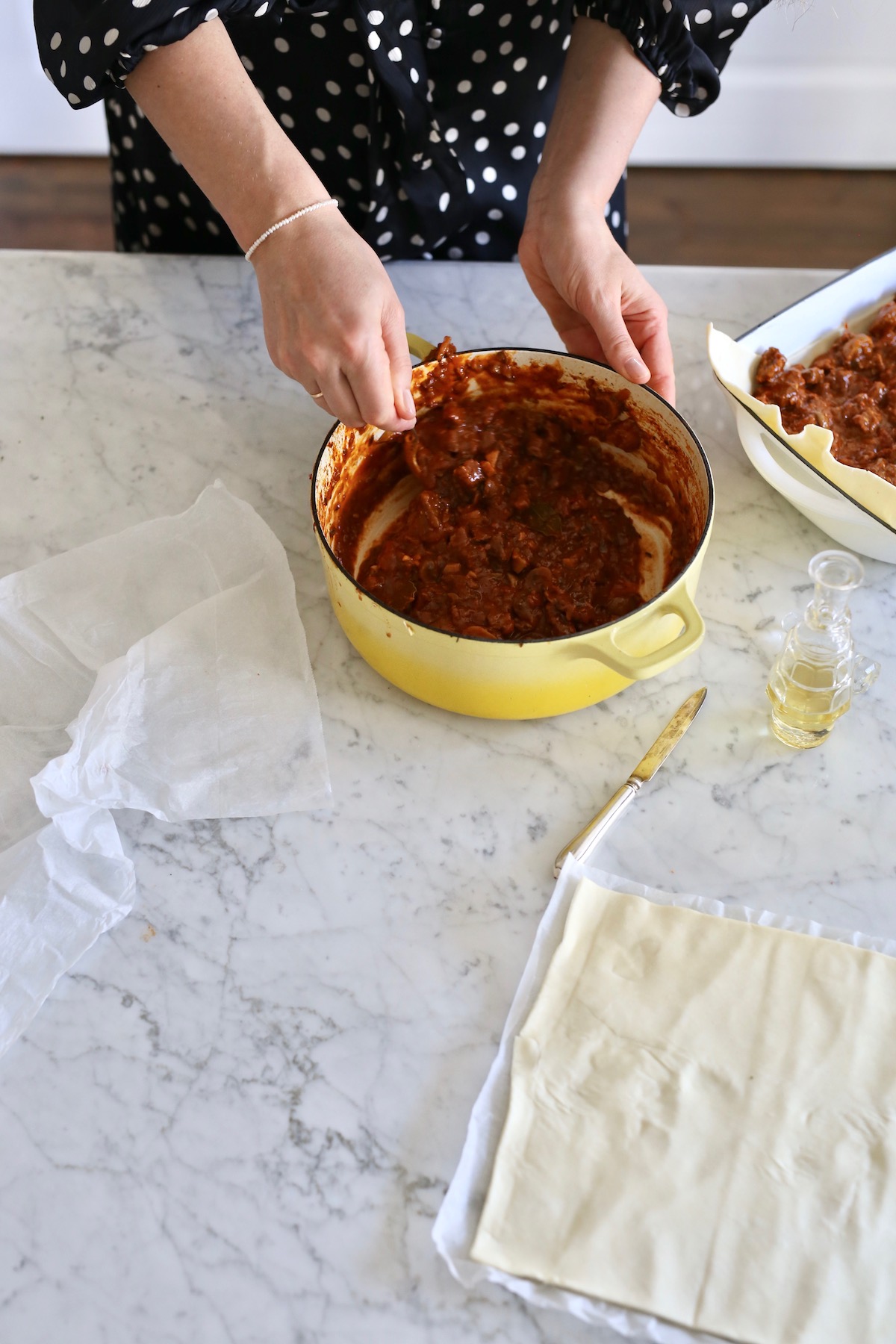 Dice the washed and dried meat (I recommend sharpening the knife beforehand as you’ll have a lot of cutting). In a wide, iron-cast dish, heat up some olive oil and slightly fry chopped garlic, onion, bay leaves, allspice corns, and smoked paprika (it’s an important moment as it’s all about filling the dish with the fragrance of all the spices). Add cut meat pieces and fry until the meat is ready. Season everything with salt and freshly ground pepper. Pour the tomato passata into the dish, decrease the heat, and cook for at least 40 minutes, stirring from time to time, so that the stew doesn’t stick to the bottom.
Dice the washed and dried meat (I recommend sharpening the knife beforehand as you’ll have a lot of cutting). In a wide, iron-cast dish, heat up some olive oil and slightly fry chopped garlic, onion, bay leaves, allspice corns, and smoked paprika (it’s an important moment as it’s all about filling the dish with the fragrance of all the spices). Add cut meat pieces and fry until the meat is ready. Season everything with salt and freshly ground pepper. Pour the tomato passata into the dish, decrease the heat, and cook for at least 40 minutes, stirring from time to time, so that the stew doesn’t stick to the bottom.
* * *
Umyte i osuszone mięso kroję na małe kawałki (tu polecam wcześniej naostrzyć nóż, bo krojenia jest sporo). W szerokiem, żeliwnym naczyniu rozgrzewamy oliwę i delikatnie podsmażamy posiekany czosnek, cebulę, liście laurowe, ziele angielskie oraz wędzoną paprykę (to ważny moment, gdyż uwalniamy zapach wszystkich ziół). Dodajemy pokrojone kawałki mięsa i smażymy, aż mięso będzie gotowe. Doprawiamy solą i świeżo zmielonym pieprzem. Całość zalewamy passatą, zmniejszamy płomień i gotujemy min. 40 minut, od czasu do czasu mieszając, żeby gulasz nie przywarł do dna.
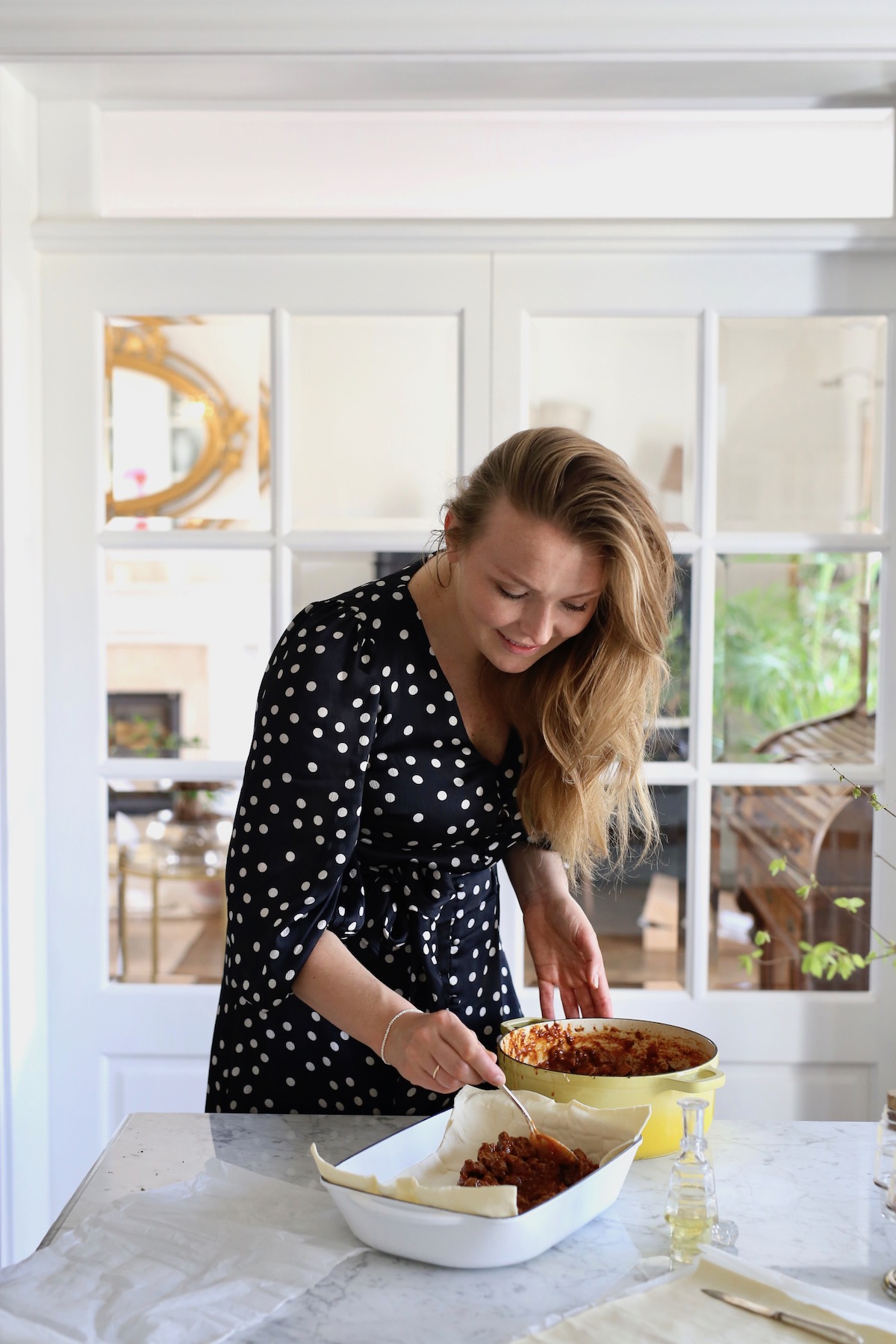 Line a greased heat-resistant dish or baking tray with puff pastry. Note: you can slightly bake the bottom first in an oven pre-heated to 200ºC. That’s how you can avoid a raw bottom. Then, spread the stew on the bottom (you don’t need to heat it up beforehand). Cover it with the remaining piece of the puff pastry.
Line a greased heat-resistant dish or baking tray with puff pastry. Note: you can slightly bake the bottom first in an oven pre-heated to 200ºC. That’s how you can avoid a raw bottom. Then, spread the stew on the bottom (you don’t need to heat it up beforehand). Cover it with the remaining piece of the puff pastry.
* * *
Natłuszczoną żaroodporną formę lub blachę wykładamy ciastem francuskim. I tu uwaga: spód możemy wcześniej lekko podpiec w rozgrzanym piekarniku w 200 stopniach C, wówczas unikniemy surowego spodu. Następnie na podpieczony spód rozkładamy gulasz (wcześniej nie trzeba go podgrzewać). Przykrywamy pozostałą porcją ciasta.
 Incise the top layer
Incise the top layer
Nacinamy wierzch ciasta
 and cover it with whipped yolk.
and cover it with whipped yolk.
i smarujemy roztrzepanym żółtkiem.
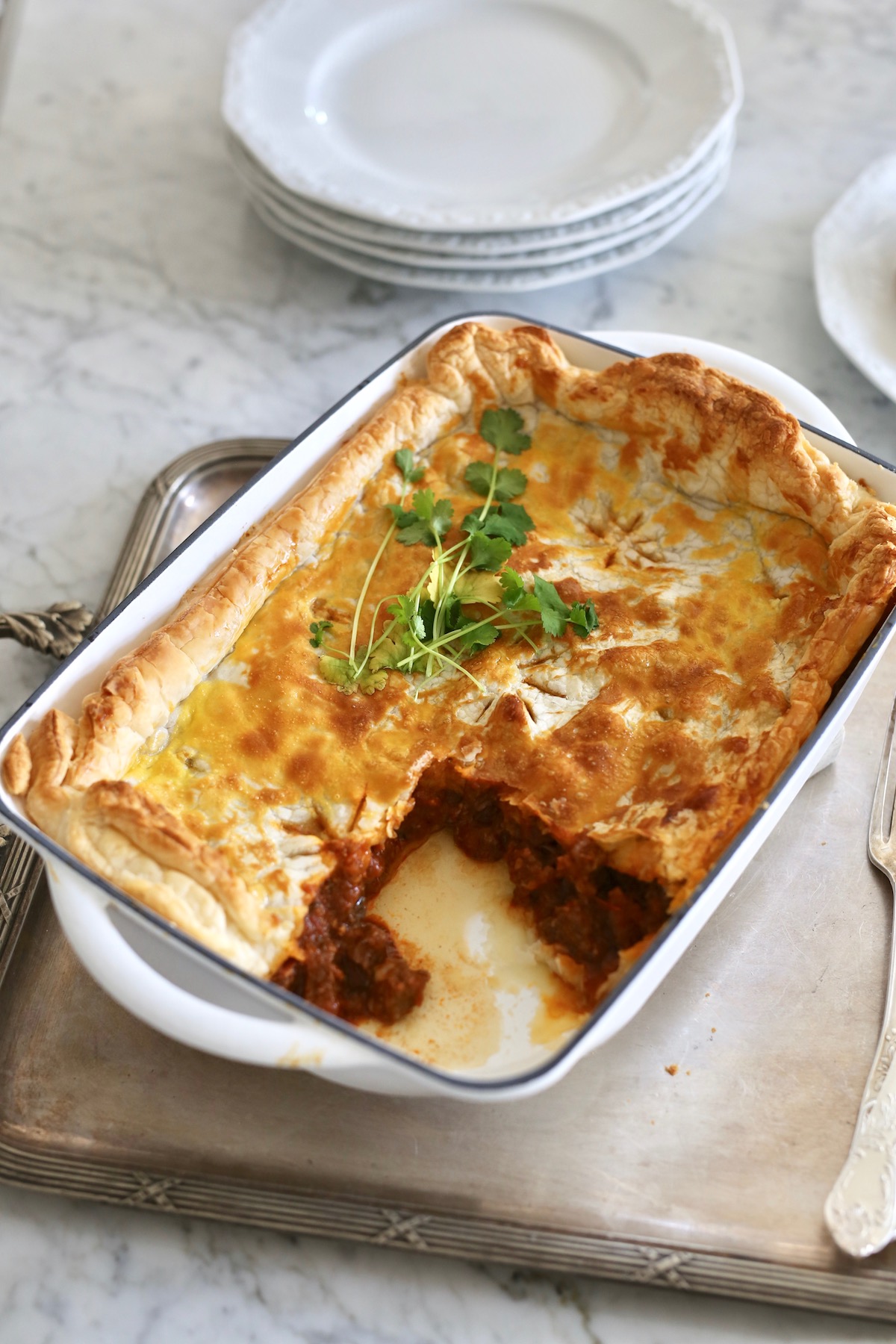 Bake everything in an oven preheated to 200ºC for approx. 20 minutes.
Bake everything in an oven preheated to 200ºC for approx. 20 minutes.
Pieczemy w rozgrzanym piekarniku w 200 stopniach C przez ok. 20 minut.
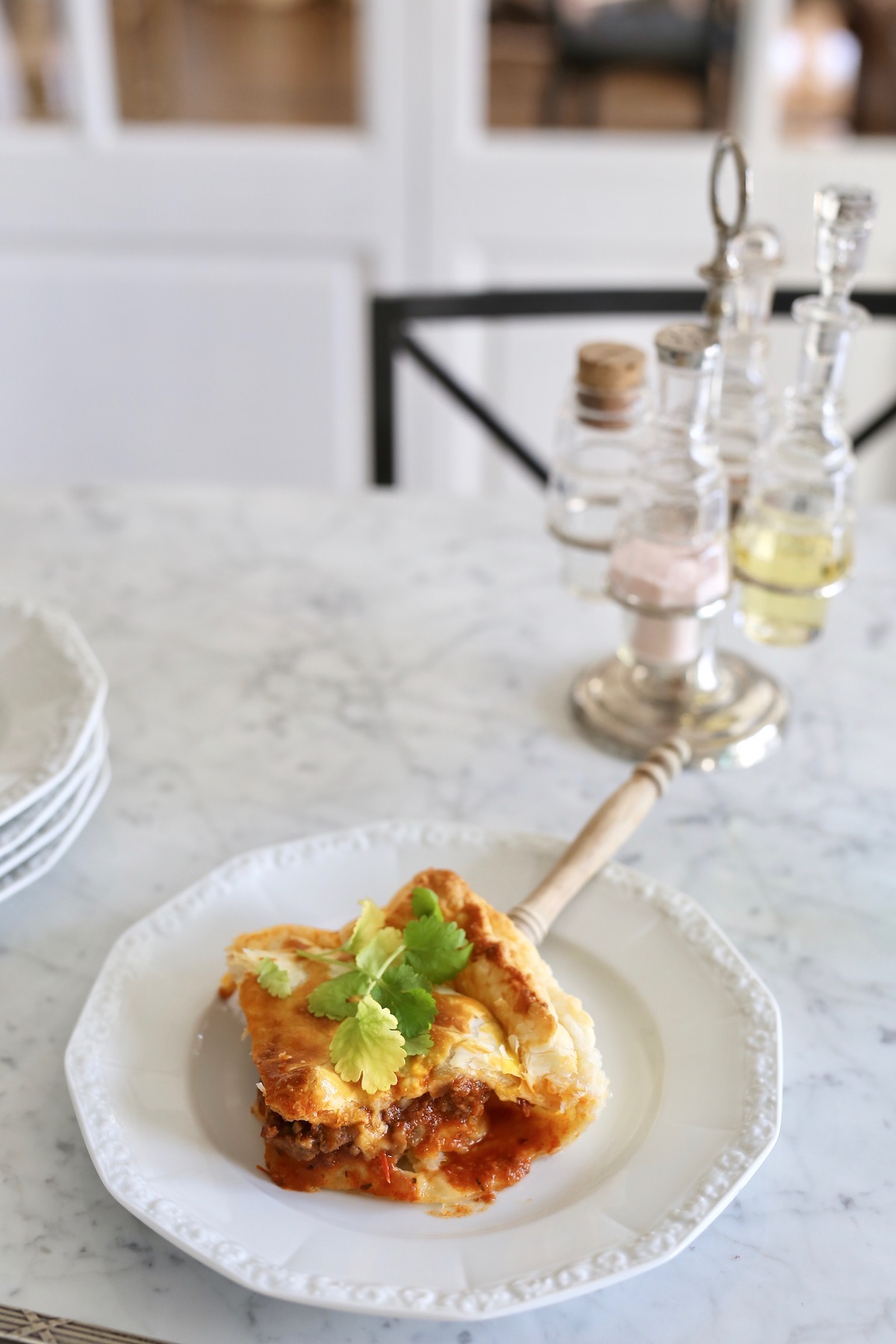 Serve hot (e.g. with sour cream mixed with a little bit of olive oil) and fresh coriander.
Serve hot (e.g. with sour cream mixed with a little bit of olive oil) and fresh coriander.
Podajemy na ciepło (np. z kwaśną śmietaną wymieszaną z odrobiną oliwy) i świeżą kolendrą.






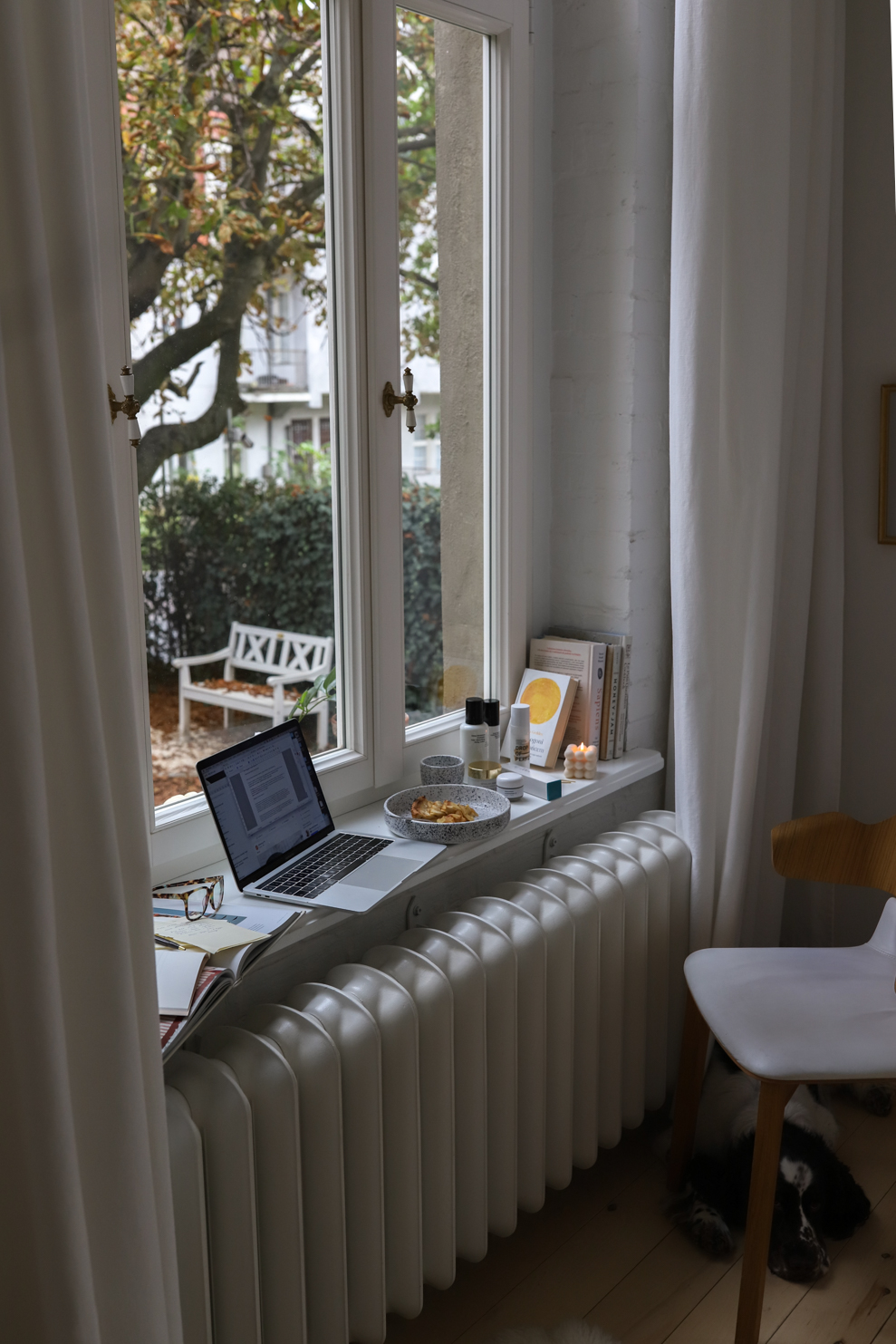


Komentarze